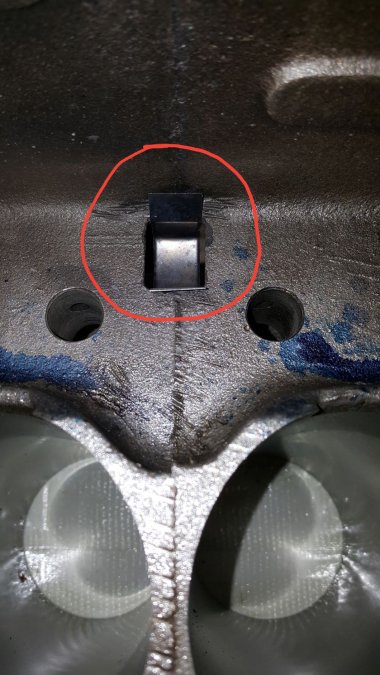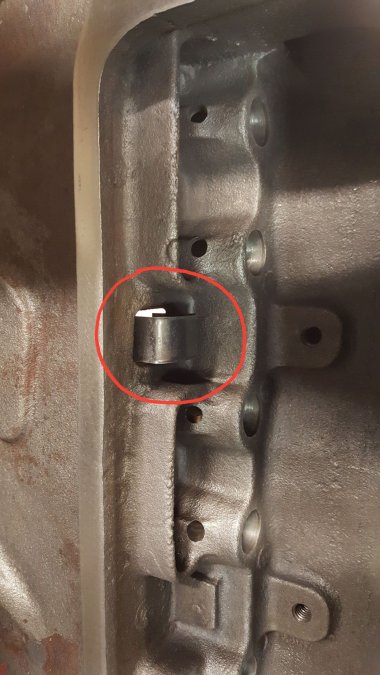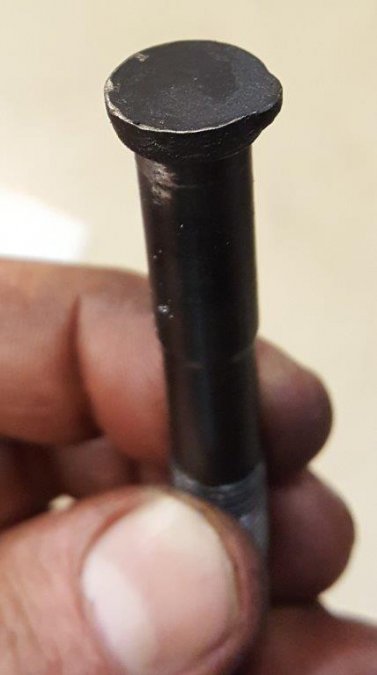
Matt Wilson
Members-
Posts
641 -
Joined
-
Last visited
-
Days Won
2
Content Type
Links Directory
Profiles
Articles
Forums
Downloads
Store
Gallery
Blogs
Events
Everything posted by Matt Wilson
-
Sniper, would you happen to have the Milodon part numbers for the studs you used? Also, I agree that studs are not needed for our relatively low-performance engines, but in my case, I plan to use them because it makes it easier to mount things to the head, such as a dual-carb intake, horn, oil filter, etc., without having to figure it all out 100% ahead of time, before torquing the bolts in place. My plan is to use studs with some extra length, torque the primary nuts in place (to torque the head and gasket), then install the items I mentioned above onto those nuts, using a second set of nuts. That will give me the flexibility to tinker with my carb linkage and such, without having to worry about getting the arrangement if all those things just right the first time.
-
I agree. I see people asking for stock head thickness info all the time, but after 60 - 80 years, I doubt there are very many that haven't been cut already. Also, I'd be a little wary if the accracy of any numbers I might find, unless they were from a factory manual or similarly reputable source. Measuring the combustion chamber volume is more tedious and time-consuming than measuring the thickness, but it's also a much more reliable way to get the answer you're looking for. Ideally, you would measure every cylinder. Once you get these volume(s), you'll have to do a little math to see if the compression ratio matches (or is close to) the original number published in your manuals. If so, then it hasn't been cut, or at least not much. Let us know if you need help with the math side of it.
-
Thanks, Bill!
-
Oddly, I can't get his page to come up on eBay either. Alternatively, you can email him at dc@jobrated.com.
-
You can also try Dave Cirillo by searching for DC Truck Parts on eBay. Very reputable.
-
You could always take an oil sample and send it off to a lab for analysis. They can tell you if there is metallic debris indicating excessive wear of bearings, pistons, rings, etc. I don't know any names of the companies that do this type of work, but I'm sure a Google search will bring up something.
-
I don't make it to this part of the site very often, and just now read your post. Very well-written, and a kind and appropriate gesture. I agree, there are some very nice and helpful people in this group.
-
I'm somewhat doubtful that Loctite will help for holding the bushing in place. The Oilite is porous, and is pre-impregnated with oil, so In doubt any adhesive would help. In fact, I suppose it's possible that the Loctite could migrate through the pores and into the inner diameter, where it would contact the transmission shaft, although I kinda doubt it would do that. The inner and outer diameters are connected through the pores, though, so just be aware of that. Some people recommend soaking the bushing in engine oil overnight before installing, just to be sure there's plenty of oil in it. I've read that grease is not recomended.
-
Custom dual master cylinder mount. Clearance concern
Matt Wilson replied to 40desoto's topic in P15-D24 Forum
Well, I plan to get full coverage on my Power Wagon, but I doubt that's the same as an umbrella policy. I guess you mean an umbrella liability policy that is not just an auto policy, but rather a general coverage umbrella policy, that would kick in and provide coverage in the event someone were to successfully sue you over an auto-related accident (and would, of course provide coverage non-auto-related incidents)? Sorry for my lack of understanding. -
Custom dual master cylinder mount. Clearance concern
Matt Wilson replied to 40desoto's topic in P15-D24 Forum
I ended up selecting a similar Willwood master cylinder for my '49 Power Wagon. I'm in the process of installing it now. One thing I will point out is that my Willwood unit, and probably many other Willwood units, if not all of them, come with a disclaimer that says they are not DOT-approved for highway use, or similar wording. I decided I wanted dual circuit brakes, and since an extensive search had not produced anything that would fit in that very tight space, I went ahead and purchased the Willwood unit. I've known of other people who have successfully used these units in vintage car applications for many years, and I think mine will work just fine and be every bit as reliable as any other master cylinder, but if I should get into a wreck, I could be under additional scrutiny by law enforcement, insurance and/or lawyers for having such a part on my truck. I've heard of people's vintage or specialty cars being torn apart at the accident scene by investigators who were looking for modifications such as these, so don't he lulled into the mindset that they won't be discovered. Eventually, I may try to find something else that is DOT-approved to fit the bill. I just wanted everyone to be aware of this potential risk, and I'd also like to hear others' opinions and experiences in this regard. -
Dual master cylinder - for stock drum brakes
Matt Wilson replied to Thomba48's topic in P15-D24 Forum
A friend of mine has relayed his experience with a failed single-circuit brake system in a 60's Mustang. He was driving along, and stepped on the brake pedal, and there was no response. He tried the brakes numerous times, to no avail. He said that was the most horrifying experience he'd ever had. He was able, by luck alone,to escape injuring anyone or damaging his car. It turns out that a steel brake lineline had rusted through, with no sign of trouble until he had complete loss of his brakes. He lived on the coast in Texas, and the lines had rusted out after 30-odd years. That's why he has been absolutely insistent that I install a dual master cylinder on my '49 Power Wagon, which I am in the process of doing now. I've heard of one Power Wagon owner who was able to stop his truck by using the parking brake when his brakes failed, but frankly, I don't know how he managed it. It's quite a reach to grab that handle sticking up through the floor at the center hump, and I'm sure I'd lose sight of the road in front of me if I had to lean over that far. I wouldn't want to rely on that. -
A shot across the bow, Exhaust Seats and Valve Guides
Matt Wilson replied to James_Douglas's topic in P15-D24 Forum
The sleeving of the lifter bores has me intrigued because I have several lifter-to-bore clearances that are well beyond factory limits, and I've been thinking of having the bores sleeved. I've looked around online and have only found sleeves for the common Ford, Chevy and Dodge V8 lifter sizes. I suppose I woild have to have them custom-made for my 265. Not sure who would do this. Also, I've read comments on several forums (mostly race forums), where people have said bronze lifter sleeves are not necessarily that good for street applications, and often don't last as long as cast iron sleeves. Others say that bronze does fine for street if they are done correctly. It seems to me that bronze would be best regardless, but I'm no expert. No doubt, there are certain types of bronze alloys that are better than others, but I don't know what those are. What kind of clearances would you be aiming for? Standard factory clearances? I have one manual that calls for 0 - 0.0007", which seems rather tight, and another manual that calls for 0 - 0.001", which still seems somewhat small, even on the high side of that range. The wear limit in one manual is 0.0015, and in another manual, it's 0.002", if I recall correctly. Modern lifter specs typically call for just under 0.001 on the low end (again, pretty tight to me) to about 0.002" or slightly more on the high end, for new parts, but those lifters are larger diameter than ours, so greater clearance my be warranted. Also, I'm not sure how the use of bronze sleeves might affect the required clearance. I'd appreciate any thoughts you have on any of this. -
Thanks! Good to know. In any case, I think I can reuse the ones I have. They look like they're in pretty good shape. I figure they're there for a reason, so I should put 'em back in.
-
Interesting...so we at least know they are called baffles, although the parts book that Dodgeb4ya shows only lists one of each baffle, but my engine has two of the larger kind. Even though these clips or baffles are fitted to the holes that lead from the tappet chamber to the crankcase, they are still rather open to the crankcase. There are big gaps under these baffles that would let oil readily flow back to the sump. But maybe there's just enough of a restriction or a splash effect to help the oil go where it needs to go. Hmmmm....if I don't forget, I may call Vintage Power Wagons tomorrow and see what they can tell me. Edit: This just occurred to me....maybe their purpose is to keep too much oil from being slung by the rods and crankshaft into the tappet chamber, which could promote leakage past the valve cover gaskets. Maybe this what you were getting at, JBNeal? Or maybe they keep excess oil from getting into the tappet chamber and getting up into the valve guides and sucked into the engine through the intake valves? Still somewhat of a mystery, but I feel a little less baffled by it all now.?
-
My 251 came out of a 1963 Dodge Power Wagon, which I think would not have been an industrial engine. I guess I'll put those clips back in when I reassemble the engine, but it would be nice to know what they're for.
-
Hi All, Does anyone know what these sheet metal clips are for? They were in the 251 that I disassembled to convert to a 265. My 230 did not have them. There are three of them in the engine, all in the tappet region. The front and rear ones are a little different from the middle one. The first image shows one of them from under the engine, and the second image shows one of them from the tappet area. Thanks.
-
Dang, I wish I'd found this source before I paid about $4 each through NAPA a few weeks ago. Oh well. I paid that price because, like you, I couldn't find them anywhere else. The guy at NAPA had to scrounge a bit from his various warehouses to get a set of 10 for me (I got extras in case I screw any of them up during install).
-
Thanks. I did look at a few YouTube videos before starting. I knew I had one, or possibly two strikes against me. My drill press only goes down to 400 rpm, which is likely too fast for the size of hole I was trying to make. Second, my hole saws are not particularly high quality. Now I realize there was a third strike. I could have sworn that the packaging for one saw said it was made for mild steel, but when I looked at it again just now, it says it is for plastics and wood, and NOT to use for metal. The other saw is not in the same packaging, but it looks like exactly the same saw as the first one. These are saws I've had for 15 years or so, and I just didn't check into their purpose very well. Lol. Maybe a fourth strike, in that I wasn't using cutting fluid, although recommended by the YouTube videos. I was only using oil or water. Oh, well, the job is done now and is good enough for my purposes. Sometimes I realize I still have much to learn, or in this case I had to re-learn that I must read the packaging! ?
-
Please pardon the slight tangent I'm taking here, but how did you cut the large holes in the plates shown in these photos? I recently had to cut large holes (2-1/8" dia and 1-1/2" dia) in some 1/4" and 1/2" steel plate (just mild steel, nothing fancy) and I didn't have a good way to do it. Though I knew it probably wouldn't work, I tried hole saws, and yep, sure enough, it didn't work. The hole saws would only penetrate slightly past the scale layer on the surface and would then stop cutting. I tried using oil and then water to cool them, but nothing helped. This was in a drill press. I ended up drilling a series of tiny holes around the circumference of each of these big holes (again in the drill press) and then using my Dremel with cutoff wheels to cut between these small holes in order to finish the removal of the big holes. Definitely not an efficient way to do it, and left a very jagged edge inside each big hole. Thanks for any guidance you might offer. Back on topic: I find this carburetor topic interesting, as I have two of Langdon's carbs that I plan to install on a Nicson dual-carb intake manifold on my 265 flathead, whenever I finally get that thing done.
-
I'm leaning toward using studs on my 265 rebuild. The main reason is that, if I order long studs for all 21 locations, it gives me added flexibility for locating the brackets and things associated with the dual-carb throttle linkage setup I plan to use. It also gives me added flexibility for accessories like the horn, but the main reason is for the throttle linkage. I don't think I would have such flexibility in a bolt setup, since only a small handful of bolts have the threaded recess in the head of the bolt. I also like the idea of having more uniform clamp-up across all studs, regardless of whether the stud goes into the water jacket or not - as opposed to the somewhat less uniform clamp-up that you get with bolts, because some need sealant to go into the water jacket and others don't (friction varies from the dry bolts vs. the bolts with sealant). I suppose I could overcome this by using sealant on all bolts, regardless of whether they go into the water jacket or not. I may take the time over the holidays to use ARP's catalog to figure out which studs would be right for my application. Matt
-
Dual intakes and air cleaner options
Matt Wilson replied to bkahler's topic in Mopar Flathead Truck Forum
I suggest you contact George Asche or Tim Kingsbury. I believe they are selling dual and/or triple-carb intake manifolds for the 25" engines such as yours. -
Well, that's unfortunate. However, I suspect that with good care, the galvanized steel tubes will probably last many, many years.
-
A couple of years ago, there was someone on Ebay selling NOS brass water distribution tubes, but I did a quick search on Ebay just now and couldn't find any brass ones. Doing a search of the forum archives should bring up the seller's name and if they are still there, you might get lucky enough to find them. I seem to remember them being pricey - something like $150 each.
-
Recommended books for engine rebuild
Matt Wilson replied to Stewart Woollard's topic in P15-D24 Forum
There's also a thread titled "Engine Rebuilding Gotchas" under the Technical Archives of this forum, pinned at or near the top of that page. Most of the discussion in that thread applies to most if the Mopar flathead sixes, including the 218. There's also an Army manual sold by Vintage Power Wagons, which covers the 230 engine, but virtually everything would apply to the 218, except things like crankshaft stroke. Fastener torque, clearances, etc., are all the same as on the 218. Others here can confirm this. This manual goes into pretty great detail. I don't have the manual number in front of me, but if you call them, they will know what you are talking about, or you can find it on their website, I'm sure. They may also recommend a rebuild manual for the Chrysler industrial engines. It's pretty good, but the Army manual may be a little better. I have both, and they are both a lot better than the Dodge Truck factory manual that I have, in that they provide a lot more instructional details and specifications. -
Thanks, I will definitely be giving him a call. I took a look at his Facebook page, and he definitely goes for the vintage iron, including a lot of old Mopar flathead sixes. He even has a couple of posts about the detailed rework and upgrades he does on rods. Sure seems like he knows what he's doing! If anyone can do what I need on those bolts, it looks like he would be the one.




